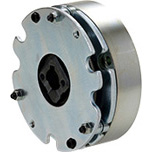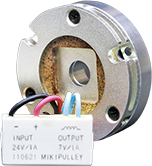![]()
Features of BEM Models
These are compact power supplies for controlling spring-actuated brakes with rated voltages of 45 V DC/90 V DC/180 V DC. The direct current required to operate electromagnetic clutches and brakes can be obtained simply by connecting/inputting using AC 100, 200 or 400 V specifications.Since the entire case is molded of resin, they can be used in adverse environments and atmospheres, such as dusty locations, and they are compact and lightweight.
Related Product

Basic Specifications
- Brake torque 2 N・m to 22 N・m
- Outer diameter of brake 83 mm to 158 mm
- Operating temperature -10℃ to 40℃

Basic Specifications
- Brake torque 0.06N・m~3.20N・m
- Outer diameter of brake 26 mm to 71 mm
- Operating temperature Brake -10℃~40℃、Controller -20℃~60℃

Basic Specifications
- Input voltage AC 100 V, AC 200 V, AC 400 V
- Output voltage DC 45 V, DC 90 V, DC 180 V
- Operating temperature -10℃ to 60℃

Basic Specifications
- Input voltage AC 100 V, AC 200 V, AC 400 V
- Output voltage DC 45 V, DC 90 V, DC 180 V, DC 360 V
- Operating temperature -10℃ to 60℃
 日本語
日本語 English
English Deutsch
Deutsch 中文
中文 한국어
한국어











